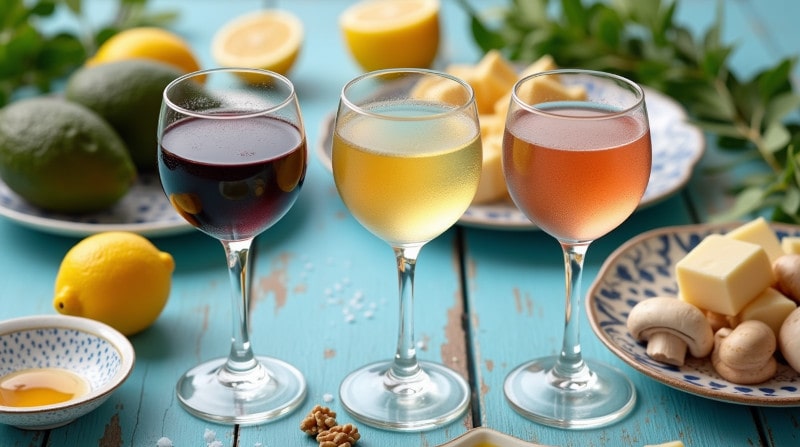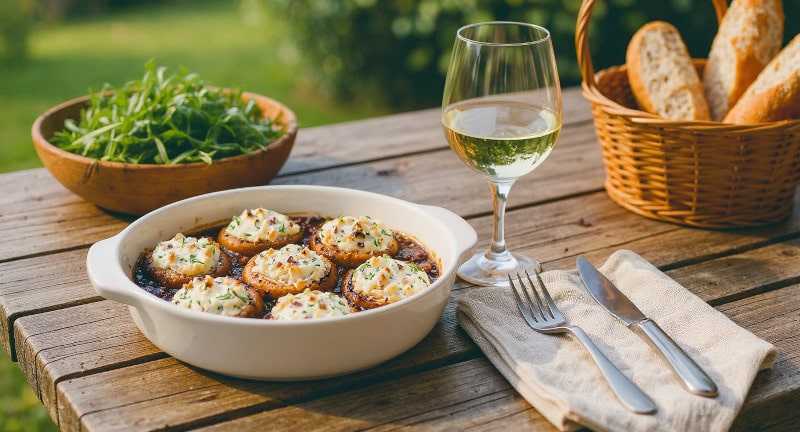Tips & tricks for the perfect fit
Sometimes you already have the wine in your glass and only then realize that it doesn’t go perfectly with the dish. But don’t worry – you can make the pairing more harmonious with a few small adjustments. Here are some practical tricks for matching food to wine.
1. add acidity – freshness as a balancing factor
Acidity enhances the freshness of a dish and can help to make wines with high acidity (e.g. Riesling, Sauvignon Blanc) appear more harmonious.
🔹 When does acid help?
- If the dish seems too greasy or heavy.
- If the wine appears stale or flat due to the food.
- If a sweet wine (e.g. late harvest) seems too dominant.
🔹 How can you incorporate acid?
- A dash of lemon juice → Perfect for fish dishes or creamy sauces.
- Vinegar (balsamic vinegar, white wine vinegar, sherry vinegar) → Harmonizes with hearty dishes and fresh salads.
- Jus or reductions with tartaric acid → A vinegar jus or reduction can lighten up heavy dishes.
💡 Example: A Chardonnay with too little acidity goes better with a dish if you round off the sauce with a little lemon juice.
2. balance sweetness – if the wine seems too dry
A wine that is too dry can feel unpleasant with bitter or very salty food. A slight sweetness in the food helps to balance this out.
🔹 When does sweetness help?
- If the wine seems too bitter or tannic.
- When a dish with a lot of acidity makes the wine appear unpleasantly sharp.
- If a heavy red wine (e.g. Cabernet Sauvignon) seems too hard.
🔹 How can you add sweetness?
- A touch of honey or maple syrup → Perfect for sauces or glazes.
- Caramelized onions or vegetables → Works perfectly with strong red wines.
- Fruity chutneys or sauces → E.g. cranberries with game or mango chutney with Asian dishes.
💡 Example: A Rioja with strong acidity and tannins will be more pleasant if the food contains a sweet component, such as a red wine reduction with honey.
3. salt as a flavor enhancer – for more structure in wine
Salt can help to make wines appear softer and fruitier.
🔹 When does salt help?
- When a tannin-rich wine seems too hard.
- When a wine with high acidity seems too sharp.
- If the dish as a whole lacks depth.
🔹 How can salt be used in a targeted manner?
- Parmesan or matured cheese → Gives dishes an umami note and softens tannins in red wine.
- Salt crust or coarse sea salt → Enhances the fruit in wines with high acidity.
- Soy sauce or fish sauce → Adds depth to umami-rich dishes and goes well with mineral wines.
💡 Example: A Barolo with strong tannins looks rounder if you round off the meat with a little parmesan or coarse salt.
4. adjust fat & creaminess – to make wines appear smoother
Fat balances acidity in wine and softens tannins.
🔹 When does fat help?
- If the wine is too acidic and the food is too spicy.
- When a tannin-rich red wine seems too dry.
- If the dish does not have enough body to keep up with a heavy wine.
🔹 How can you add fat?
- A knob of butter or cream in the sauce → Makes red wines with strong tannins smoother.
- Olive oil or truffle oil → Adds depth to dishes and reduces acidity in wine.
- Avocado or nuts → Complement fruity white wines with few tannins.
💡 Example: A strong Bordeaux looks less austere if the dish is complemented with a butter sauce or a fatty component such as avocado.
5. enhance umami – depth and complexity for pairing
Umami can help to better integrate wines with structure and deepen the flavor.
🔹 When does umami help?
- If the wine tastes too one-dimensional.
- When a red wine with tannins is not properly integrated into the food.
🔹 How can you add umami?
- Mushrooms or dried tomatoes → Perfect for Pinot Noir or mature wines.
- Fish sauce or miso paste → Adds depth to the dish and emphasizes mineral notes in the wine.
- Fermented foods (e.g. kimchi, parmesan) → Complement complex wines with a lot of structure.
💡 Example: A Nebbiolo goes better with a dish if you give it more umami with mushrooms or parmesan.
6. use carbon dioxide – loosen up heavy dishes
Sparkling wines can balance fatty or creamy dishes and provide freshness.
🔹 When does carbon dioxide help?
- If a dish seems too heavy or greasy.
- When a wine does not have enough freshness.
🔹 How can you incorporate carbon dioxide into pairing?
- Champagne or Crémant as an accompaniment to fried food → The perlage cleanses the palate.
- Light sparkling mineral water as an alternative → Can help if no suitable wine is available.
💡 Example: A glass of champagne with fried prawns provides a nice contrast and makes the pairing more elegant.
Conclusion: Small adjustments – big effect in wine pairing
With these simple tricks, you can adapt an already finished dish to the wine instead of opening a different wine afterwards. Acidity, sweetness, salt, fat, umami and carbon dioxide are the keys to making a pairing more harmonious or exciting.
🍷 Experiment with these adjustments and find out how you can perfectly match each dish to the wine!




